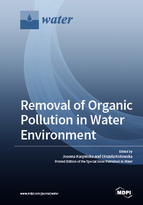Removal of Organic Pollution in Water Environment
A special issue of Water (ISSN 2073-4441). This special issue belongs to the section "Wastewater Treatment and Reuse".
Deadline for manuscript submissions: closed (24 June 2019) | Viewed by 55960
Special Issue Editors
Interests: study of processes determining the durability of selected biologically active compounds in the environment; new photocatalysts; endogenous antioxidants; liquid chromatography
Special Issues, Collections and Topics in MDPI journals
Interests: determination of emerging contaminants in wastewater; leachate and other objects of the water environment; phytoremediation; microextraction techniques; gas chromatography; mass spectrometry
Special Issues, Collections and Topics in MDPI journals
Special Issue Information
The planned Special Issue will include the following topics:
Emerging pollutants (EPs) in waters
Endocrine active compounds in the water environment
Occurrence and fate of emerging contaminants in various water bodies
Advances in water purification processes
New advanced oxidation processess
Environmental risk assessment, toxiticity of emerging contaminants, their fate in the food chain
Leacheates of municipal landfills, their impact on groundwater quality and problems with its utilisation
Analytical methods employed to monitor the presence of EP in waters and for the monitoring of water purification processes
Phytoremediation of wastewaters
Purification of industrial wastewater
Sorption methods in wastewater treatment
Prof. Dr. Joanna Karpińska
Dr. Urszula Kotowska
Guest Editors
Manuscript Submission Information
Manuscripts should be submitted online at www.mdpi.com by registering and logging in to this website. Once you are registered, click here to go to the submission form. Manuscripts can be submitted until the deadline. All submissions that pass pre-check are peer-reviewed. Accepted papers will be published continuously in the journal (as soon as accepted) and will be listed together on the special issue website. Research articles, review articles as well as short communications are invited. For planned papers, a title and short abstract (about 100 words) can be sent to the Editorial Office for announcement on this website.
Submitted manuscripts should not have been published previously, nor be under consideration for publication elsewhere (except conference proceedings papers). All manuscripts are thoroughly refereed through a single-blind peer-review process. A guide for authors and other relevant information for submission of manuscripts is available on the Instructions for Authors page. Water is an international peer-reviewed open access semimonthly journal published by MDPI.
Please visit the Instructions for Authors page before submitting a manuscript. The Article Processing Charge (APC) for publication in this open access journal is 2600 CHF (Swiss Francs). Submitted papers should be well formatted and use good English. Authors may use MDPI's English editing service prior to publication or during author revisions.
Keywords
- wastewater
- municipal landfields leachate
- groundwater
- emerging contaminants, advanced oxidation methods
- phytoremediation
- environmental risk assessment
- endocrine disrupting compounds







